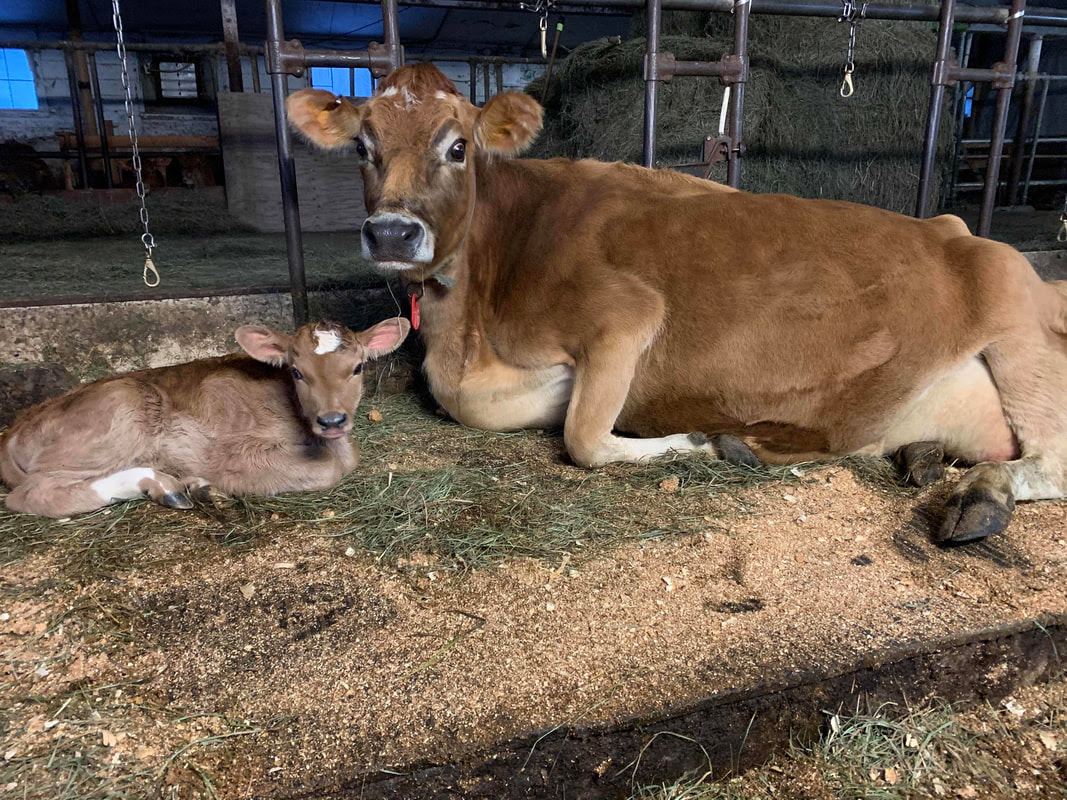|
Last week, we left our intrepid bovine, Polywog, lowing proudly to her new and very wet calf. We dried off the calf and stuck her underneath a pile of hay to keep warm. Momma got warm water (so as not to chill her) and endless second-cut hay. All was calm, all was well. We always keep the cow in the barn for a day or two after calving just to keep an eye on her. Polywog seemed to be doing fine until late afternoon the following day when she wouldn’t get up. This is a classic sign of “milk fever” which is common in cows. It’s a misleading term as it has nothing to do with fever, but rather calcium. Milk contains calcium, which is produced in the bones. Sometimes, though, a cow cannot produce calcium quickly enough with the sudden onset of lactation. The body’s solution is to pull it from another, readily available source: muscles. Unfortunately, you need calcium to control your muscles. Without it the animal cannot stand, curls up into a fetal position, systems shut down and the animal dies. It happens suddenly. Thankfully, the solution can be just as dramatic -an IV of calcium straight to the bloodstream can bounce the cow back in minutes. So we gave her a bottle, but instead of getting better she started to convulse. It’s cold in the barn and she was not maintaining body heat. We grab a (very nice!) wool blanket and toss it over her. It’s not enough. Lisa races home and brings back a sleeping bag (MY sleeping bag; what about hers?) and we put that over Polywog too. Then Lisa and I basically sprawl over the cow trying to add our body heat while gently rocking her. A second bottle of calcium produces improvement, but it is short lived. We’re running out of options -and time. I call the vet who suggests a third bottle of calcium, but ends with the caveat “It may also overwhelm her heart, but either way you’ll have done what you could.” This is not a choice I want to make. We’re about to lose this wonderful cow. So we compromise and give her half of the third bottle. Her shaking perceptibly slows and stops. All is calm. It worked! She’s pulled through! Then without warning her head drops. She is completely still. I’m thinking “Oh, my God. She just died.” I pry open her eyelids and her eyes are rolled back. Nooooo! Damn, damn, damn. Anguish and guilt start to overwhelm me. What could we have done differently? How could we have saved her? Could we have caught it earlier? Why did it have to be so cold? Through my grief I slowly realize I can feel air coming out her nostrils. Yes, her chest just heaved. My God, she’s still with us, though barely. We give her the rest of the third bottle and wait. Time has stopped, but we are deep into the evening. It’s cold, dark, and deathly quiet except for a weak, rasping breath. I’m grieving yet irrationally hoping. She stirs her head. That’s good! Will she eat anything? We shove some molasses-drenched “medicinal” grain under her nose. She sniffs and starts to eat it! Yeah! After a few minutes she tries to get up, but cannot manage it. We wait another span of indeterminate time then try to get her up again. She won’t do it. I’m convinced that with the cold ambient temperature she will not make it through the night. We’ve got to get her up and moving around! But how? Hold on. I know what will motivate her. We fetch the calf and put it next to her. Momma sees her baby, lows softly then more vigorously and starts to lick her. With a little encouragement, Polywog gets ups. She's unsteady, but tries to follow her calf, which is racing around. We catch the calf and guide her to Momma’s milk. At that moment, cow and calf both find what they are looking for. Each is alive because of the other. Pollywog and her calf, Lillypad, the next morning.
0 Comments
Leave a Reply. |
AuthorRandy Robar, co-owner of Kiss the Cow Farm Archives
August 2022
Categories |
© COPYRIGHT 2024, KISS THE COW FARM. ALL RIGHTS RESERVED.
Website design by Free Verse Studio.
Website design by Free Verse Studio.


 RSS Feed
RSS Feed